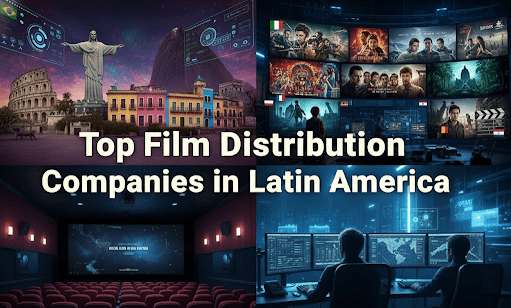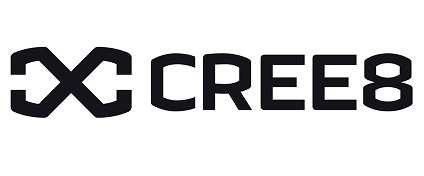Top Film Distribution Companies in Latin America (2025): A Strategic Sourcing Guide

Introduction
The landscape of film and television content distribution in Latin America is defined by high growth, complex regulatory environments, and a rapid acceleration toward digital-first models.
For Content Acquisition and Strategy executives, successfully navigating this market requires more than a standard vendor list; it demands a strategic partnership with entities capable of executing on both theatrical exhibition and sophisticated digital distribution/VOD strategies.
This guide is built to serve as your foundational market intelligence document, providing an evaluated list of the region’s key distribution players alongside the framework required for high-stakes sourcing decisions.
Table of content
- The Strategic Imperative: Why Latin America is the Next Distribution Frontier
- Our Strategic Evaluation Framework: Selecting Top Film Distribution Companies in Latin America
- The Top 10 Film Distribution Companies in Latin America (2025)
- Operationalizing Partnerships: How to Integrate These Top Film Distribution Companies
- How Vitrina Solves the Distribution Sourcing Challenge
- Conclusion
- Frequently Asked Questions
Key Takeaways
| Core Challenge | Fragmented visibility into partner track records, territorial coverage, and current deal activity in a high-growth market. |
| Strategic Solution | A pre-vetted list of the top film distribution companies in Latin America, benchmarked against critical market and operational criteria. |
| Vitrina’s Role | Providing the real-time project tracking and verified collaborator data necessary to vet these partners and close high-value, data-driven deals. |
The Strategic Imperative: Why Latin America is the Next Distribution Frontier
The Latin American media and entertainment (M&E) industry is no longer an emerging market; it is a critical growth engine for global content enterprises. According to insights presented by Omdia, the region’s M&E industry is projected to reach $55 billion in 2025, a growth rate of 9.4%, which significantly surpasses the global average of 6%.
This robust expansion is predominantly fueled by the accelerating adoption of digital video services. Nearly half of this revenue—an estimated $24 billion—will stem from streaming video in 2025.
The shift is particularly pronounced in the FAST (Free Ad-supported Streaming TV) sector. Omdia data highlights that Latin America is set to be one of the fastest-growing markets for FAST over the next five years, with revenues projected to soar from $231 million in 2024 to $569 million by 2029.
This trend creates a dual mandate for content distributors: mastery of traditional theatrical exhibition logistics must be coupled with sophistication in managing rights across a fragmented and rapidly growing digital platform ecosystem. Furthermore, the strategic value of local content cannot be overstated.
Countries like Brazil and Mexico are driving the majority of this growth, signaling an executive need to partner with companies that possess deep, localized market knowledge and established government and exhibitor relationships. Choosing the right partner here is a strategic act of film acquisition and licensing that directly impacts market share and ROI.
The operational complexity is compounded by a high volume of local production. While global majors retain significant influence, the distribution ecosystem is increasingly decentralized.
Executives must filter through a vast number of potential partners, each with unique strengths in specific territories (e.g., the Andean region) or specific content niches (e.g., telenovelas, high-end drama). This demands a disciplined, data-first approach to partner scouting, moving beyond basic reputation to verifiable track record and strategic alignment.
A robust content distribution strategy for the region requires an understanding of how to manage simultaneous, localized release windows across a highly variable technological and regulatory landscape.
Our Strategic Evaluation Framework: Selecting Top Film Distribution Companies in Latin America
In a market defined by rapid change and intense competition, the selection of top film distribution companies in Latin America must be based on a verifiable, quantitative framework. I use a three-pillar evaluation system designed for the senior content executive:
- Market Footprint & Territorial Rights Mastery: A top-tier distributor must demonstrate more than just an office presence. They must show a history of successful releases across critical markets—Brazil, Mexico, Argentina, Colombia—and have a clear strategy for managing territorial rights across simultaneous theatrical, TV, and VOD windows.Their ability to manage currency fluctuations and differing local regulations is paramount. The distributor must have a documented history of navigating the region’s complex legal landscape regarding import, censorship, and local content quotas.
- Dual-Channel Execution Capability: The era of theatrical-only distribution is over. The ideal partner must excel at both traditional and modern channels. This means proven relationships with major theatrical chains and established deal flow and technical capability for servicing global and regional streaming platforms, including expertise in the surging FAST market.The distributor must demonstrate fluency in both physical logistics and digital supply chain management, proving they can execute a unified, multi-platform release that maximizes revenue from all potential windows.
- Content & Genre Specialization: Given the strong appetite for regional content, a distributor’s specialization is key. Executives should look for partners whose most recent activity aligns with their genre (e.g., premium drama, animation, documentary).A distribution company’s recent collaboration history reveals its current strategic focus and its network within the local creative ecosystem, a critical factor for successfulcontent distribution strategy. Selecting a firm that has recently collaborated with known production houses in the Latin American M&E industry provides a strong signal of their operational expertise in that niche.
This framework allows us to move past superficial branding and evaluate the true operational capacity and market relevance of any potential distribution partner. It requires moving from a static list of names to a dynamic assessment of their verifiable deal flow and execution performance.
The Top 10 Film Distribution Companies in Latin America (2025)
This curated list represents a selection of influential players in the Latin American content distribution ecosystem, spanning major global studios with deep regional roots to specialized local firms. Each company’s operational profile reflects its commitment to navigating the complex landscape of theatrical, TV, and digital rights management across Latin America.
- The Walt Disney Company Latin America
As a major studio powerhouse, Disney’s Latin American distribution arm manages an extensive portfolio spanning feature films, television, and direct-to-consumer platforms. Its strategy combines high-profile Hollywood blockbusters with an increasing focus on developing and distributing high-quality local content, ensuring dominance across theatrical windows and its comprehensive streaming ecosystem, which is a major driver of the region’s overall media revenue. The company’s integrated model allows for tight control over the entire distribution lifecycle, from theatrical exhibition through to streaming on Disney+ and Star+. - AE Global Media Latin America
AE Global Media often focuses on leveraging its regional network to manage multi-platform media rights, specializing in the distribution of specific-interest or niche content, particularly in the television and digital spaces. The company utilizes both traditional broadcast and emerging digital platforms to maximize audience reach and monetization across diverse Latin American territories, often acting as a key licensor for catalog content to regional TV networks and SVOD players. - Warner Bros Discovery Latin America
Following its merger, this entity is a dual-force in the region, managing the distribution of a vast library of films and television series, including both premium and popular content. Its strategy centers on maximizing distribution value through strategic theatrical releases, leveraging its extensive catalog for TV licensing, and driving subscription growth across its suite of streaming services like Max. They are a critical player in both the major theatrical markets and the rapidly expanding digital landscape. - Sony Pictures Television Latin America
Sony Pictures focuses heavily on the television and episodic content distribution space, licensing a broad array of genres to free-to-air, pay-TV, and digital distribution/VOD platforms throughout the region. The company is a key supplier of high-demand scripted and non-scripted series, adapting its content distribution strategy to the evolving pay-TV and SVOD landscape by utilizing its strong regional relationships for premium placement. - Star Distribution Latinoamérica
A major regional player, Star Distribution manages theatrical and home entertainment distribution for a significant volume of studio and independent films, particularly across the Southern Cone and other key territories. The company has a strong footprint across various Latin American countries, offering comprehensive campaign management from exhibition to digital home video release, making it a reliable choice for films requiring broad cinema coverage. - Top Film Distribution
Top Film Distribution is generally recognized for its focus on acquiring and releasing a diverse slate of independent and commercial films. The company leverages its targeted expertise to find niche and wide audiences, often focusing on theatrical and subsequent digital releases across key Spanish-speaking territories. Their strategy often involves localized marketing that connects global independent titles with regional cinema audiences. - Atlas Distribution
Atlas Distribution operates with a focus on maximizing film performance through tailored marketing and exhibition strategies, often specializing in commercial titles. They provide a full range of distribution services intended to optimize box office returns before navigating the subsequent VOD and home entertainment windows. The company’s strength lies in its ability to execute precise, country-by-country release plans. - NBC Latin America
NBCUniversal’s regional arm handles the distribution of its vast film and TV library, placing emphasis on both premium content licensing to third-party platforms and feeding its proprietary streaming services, Peacock and Telemundo’s offerings. Their operation is characterized by managing complex international deals for both recent releases and catalog content across multiple media rights cycles, reflecting its role as a major supplier of US content. - SFC Film Distribution Company
SFC often works with a mix of international and local productions, focusing on securing placements in key theatrical circuits and managing the digital rollout to reach a wide consumer base in high-volume territories like Mexico and Brazil. Their operational flexibility makes them a key partner for producers needing a comprehensive, cross-territory release strategy. - DCM Film Distribution
DCM is recognized in the Latin American market for its targeted approach to film releases, often specializing in specific regional releases and working closely with local exhibitors and streaming services to craft effective, localized marketing and distribution plans. They focus on delivering bespoke strategies for films that may not fit the major studio mold.
Operationalizing Partnerships: How to Integrate These Top Film Distribution Companies
Identifying the top film distribution companies in Latin America is the first step; the true strategic challenge lies in the operational handshake—integrating these partners seamlessly into your content supply chain. For senior executives, the focus must shift from a simple list to a disciplined execution plan centered on due diligence, deal transparency, and performance tracking.
- Deep Due Diligence on Deal Track Record:
Before entering negotiations, you must verify the distribution company’s recent activity. Generic press releases are insufficient. You need to identify which projects they acquired, the territories they covered (e.g., exclusively the Andean region vs. full LATAM), and the co-production/co-financing partners involved. This intelligence is crucial for understanding their strategic bias and true operational reach in terms of territorial rights. A robust project tracker is essential here to map their real-time activity and collaborations in the market. To learn more about the complexities of global transactions, I recommend reading our analysis on reputation and credentials in cross-border transactions. - Negotiating Dual-Platform Windows:
The rise of FAST and regional SVOD players demands a sophisticated approach to licensing. Avoid agreements that grant overly broad, long-term rights without clear performance metrics and termination clauses. Instead, structure deals with specified performance goals for both theatrical box office and digital distribution/VOD subscriber acquisition. As a producer or content IP owner, you should explicitly define the distribution windows and understand the distributor’s plans for localization and digital asset delivery, ensuring maximum revenue capture across a fragmented landscape. - Performance Monitoring and Transparency:
A common challenge in the distribution landscape is the lack of transparent reporting. When engaging with a distribution partner, demand a granular breakdown of revenue streams by territory and by platform (theatrical, transactional VOD, subscription VOD, FAST). This is a vital risk mitigation strategy against the historical issue of opaque accounting and cross-collateralization that can erode your net profit. Operationalizing this requires a commitment to using data platforms that track distributor-specific project movement in parallel with your internal revenue reports. This visibility is non-negotiable for maximizing the ROI on film acquisition and licensing deals. Furthermore, understanding the localization pipeline is key; the distributor must clearly articulate their plan for dubbing and subtitling to effectively reach the full scope of the Latin American M&E industry.
This visibility is non-negotiable for maximizing the ROI on film acquisition and licensing deals. Furthermore, understanding the localization pipeline is key; the distributor must clearly articulate their plan for dubbing and subtitling to effectively reach the full scope of the Latin American M&E industry.
How Vitrina Solves the Distribution Sourcing Challenge
The executive challenge in dealing with top film distribution companies in Latin America is one of visibility: you need verifiable, actionable intelligence at the speed of the market. Vitrina provides the single solution to this content distribution strategy sourcing dilemma.
Vitrina is the global leader in tracking the M&E supply chain—content, projects, companies, and collaborations. It is not a tool for casual users; it is a dedicated intelligence platform designed exclusively for executives, studios, and financiers. Our core value proposition for this use case is the eradication of information asymmetry:
- Real-Time Vetting of Distributors: The Vitrina Project Tracker provides a live feed of which distributors are acquiring which projects, in which territories, and which co-production/co-financing partners they are currently working with. You can instantly verify a distribution company’s claimed specialization and true operational capacity against its actual deal flow, giving you the upper hand in negotiations.
- Verified Contact Intelligence: Finding the decision-maker for content acquisition is a constant bottleneck. Vitrina tags over 3 million CXOs and crew-heads by department and specialization, providing daily updated and verified contact details to ensure your outreach lands directly with the right executive. This eliminates the wasted time and resources typically spent on cold outreach through general inboxes.
- Strategic Market Benchmarking: Use Vitrina’s advanced search engine to filter distributors by their historical work in the Latin American M&E industry, including specific genre experience, country focus (e.g., Brazil vs. Mexico), and recent project movement. This provides the quantitative evidence needed to select the optimal partner for your content’s unique needs. This level of precise intelligence ensures your film acquisition and licensing decisions are grounded in verifiable data. For a deeper look at content acquisition strategies, explore our information onContent Acquisition webinars and resources.
Vitrina transforms a laborious, manual scouting process into a single, high-confidence data retrieval action, ensuring you partner with the right distributor at the right time.
Conclusion
The Latin American distribution market presents an exceptional opportunity for content owners and studios, but only for those who approach it with a rigorous, data-driven strategy.
The key to success is moving beyond anecdotal evidence to quantify a distributor’s true reach, dual-channel proficiency, and current strategic focus. By applying a robust evaluation framework and leveraging advanced market intelligence tools like Vitrina, you can effectively vet the Top Film Distribution Companies in Latin America and ensure your content achieves its maximum potential across this high-growth frontier.
The future of content distribution strategy here is digital, local, and requires a highly precise approach to partner selection.
Frequently Asked Questions
You should consider the distributor’s proven track record of releases in your target territories (Brazil and Mexico are critical), their expertise in managing both theatrical and digital rights (SVOD/FAST), their financial transparency, and whether their content/genre focus aligns with your project.
They typically differ in their complexity regarding territorial rights across multiple, distinct national markets (rather than one single market), their proficiency in navigating local content quotas and regulations, and their necessity to balance a strong theatrical presence with the rapid growth of regional and global streaming services.
The most common deals involve licensing agreements for specific distribution windows, including a theatrical release window, followed by a home entertainment/digital rental window (VOD), and subsequent licensing to linear TV or streaming platforms (SVOD/FAST), often with complex split-rights arrangements by territory.
Ensure the distribution contract includes a clear, uncapped, and detailed marketing commitment with a required minimum spend, defined campaign milestones, and a clear plan for both traditional promotion and digital/social media strategy tailored to local consumer habits in key countries.
























